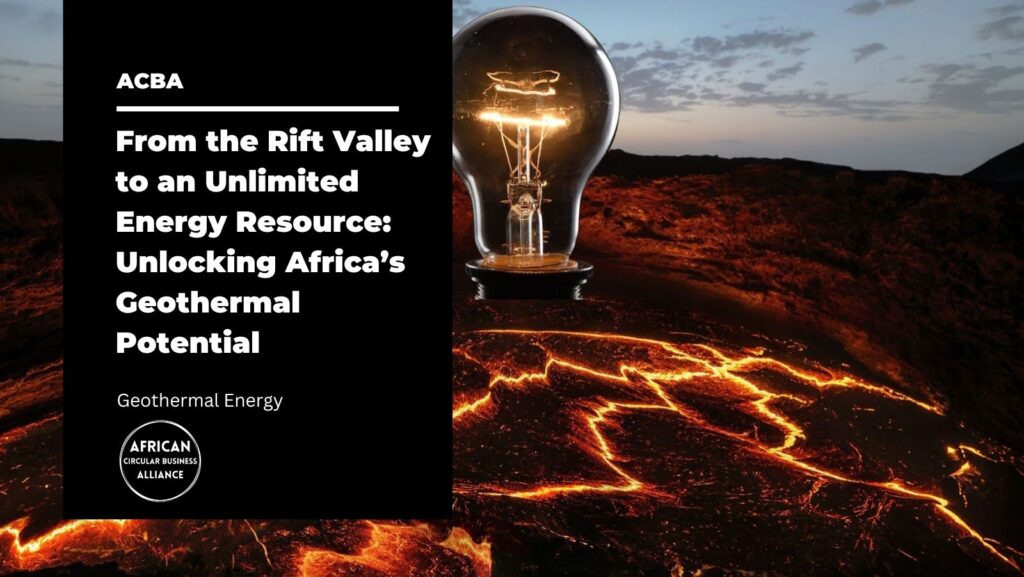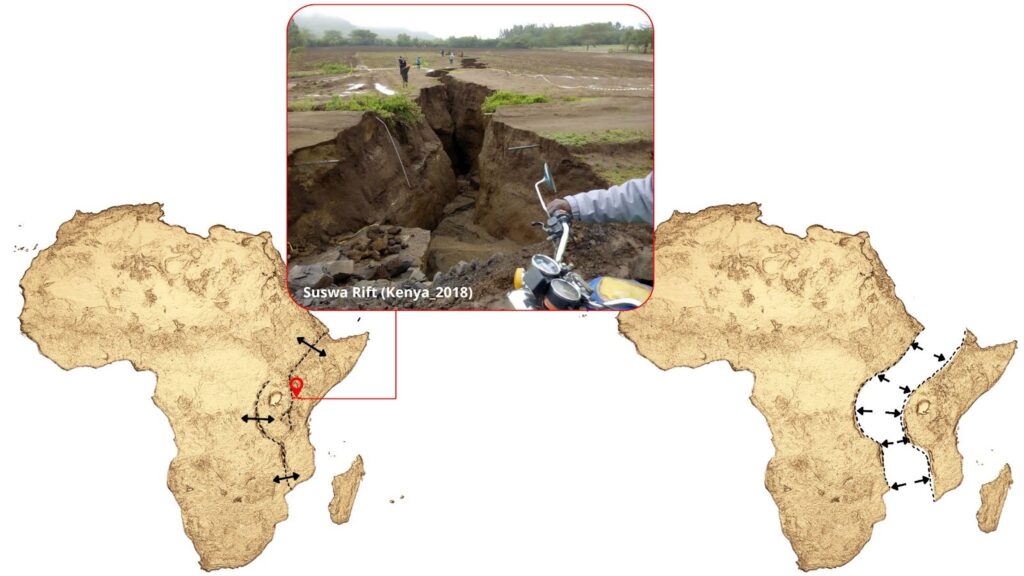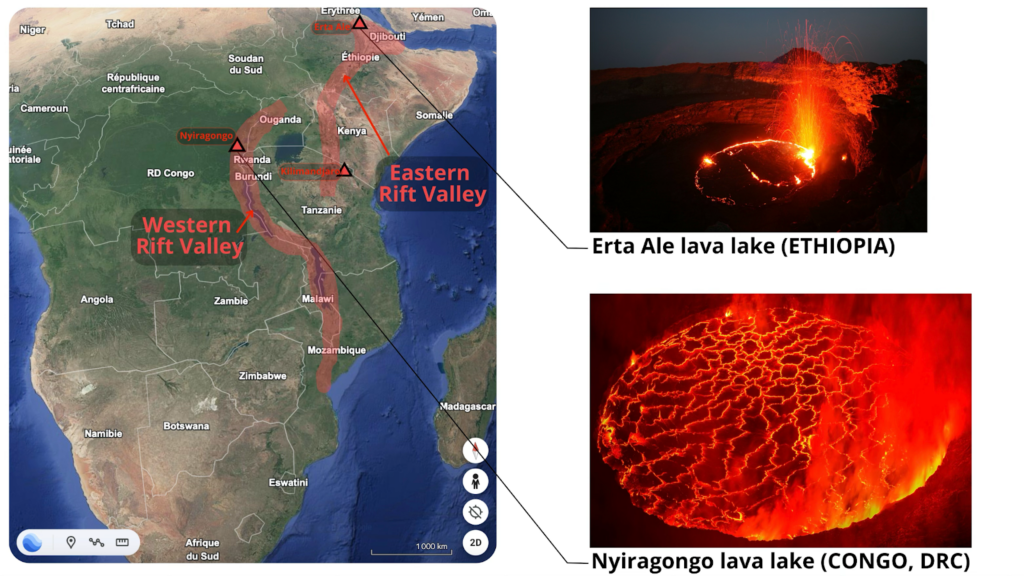Authored by Wilfried Bero and received contributions from Dr Rita Okoroafor (PhD) and Miguel Ugochukwu Peters.

It takes energy to split a continent. In recent months, Ethiopia has experienced increased volcanic and seismic activity—reminders that the African continent is in motion, slowly splitting apart. While this geological process is often seen as a source of concern, it also represents one of the continent’s greatest opportunities. The East African Rift System (EARS) is forming valleys as a surface manifestation of this tectonic activity. The EARS offers the potential to develop the cornerstone of all renewable energies: Geothermal, for both heat and electricity production.

1 – The African Rift Valleys, the marker of a continent in motion, and an energy goldmine
The East African Rift System, stretching from the Red Sea to Mozambique, is one of the world’s most promising geothermal energy frontiers. Rather than being a single linear feature, it extends over two main branches:
- The Western Branch: Uganda, Rwanda, Burundi, the Democratic Republic of the Congo (DRC), and Tanzania, Zambia, Malawi, Mozambique.
- The Eastern Branch: Eritrea, Djibouti, Ethiopia, Kenya, Tanzania.
Both branches of the East African Rift System are marked by intense seismic and volcanic activity. The Eastern Branch gave rise to Ethiopia’s Afar region and its shield volcano, Erta Ale, which stands at 613 meters in altitude and contains an active lava lake with a diameter of approximately 80–90 meters. Meanwhile, the Western Branch formed Mount Nyiragongo in the Democratic Republic of the Congo (DRC), reaching 3,470 meters in altitude and hosting the world’s largest active lava lake, measuring around 250 meters in diameter. There could be no clearer geological evidence of the region’s vast high enthalpy geothermal potential.

2 – The Iceland-Kenya partnership and its lasting impact across Africa
Iceland provides a striking example of how to harness geothermal energy in a highly volcanic and seismically active environment. Despite natural hazards, Iceland meets over 90% of its heating needs and a significant share of its electricity demand with geothermal energy—overcoming initial skepticism. This success has not only made Iceland energy-independent but also a global leader in geothermal expertise.
Iceland has exported its geothermal expertise worldwide, including to Kenya. Kenyans have leveraged this knowledge so effectively that they have now surpassed Iceland’s installed capacity. The Iceland-Kenya partnership has been instrumental in this success, proving that high seismic and volcanic activity, despite being a serious challenge, can also be an opportunity for local renewable energy supply. With 985 MW of installed capacity, Kenya is on the verge of reaching the 1 GW milestone, to join the elite “1 GW club” alongside the United States, Indonesia, the Philippines, Türkiye, and New Zealand.
Kenya’s geothermal success is now inspiring neighbouring countries to follow suit, with Kenya actively supporting their development efforts.
3 – Beyond Kenya: East African Rift Geothermal Potential largely untapped
The East African Rift leads to high heat flow and a high geothermal gradient. This means that geothermal resources are accessible at shallower depths compared to other regions in the world, reducing drilling costs and making geothermal energy an attractive and sustainable option for local baseload energy supply.
Despite the vast geothermal potential across the EARS, development remains limited in many countries. Kenya stands out as the African nation that has made the most significant progress in harnessing this resource. Its leadership has positioned Kenya as a catalyst, driving concrete actions to establish geothermal as a baseload energy source in neighbouring countries. The Rift may split the African continent apart, but geothermal energy is bringing its nations closer than ever—fueled by a collaboration with the expertise of Kenya Electricity Generating Company PLC (KenGen).
A – Ethiopia: The Aluto-Langano geothermal plant, located 200 km south of Addis Ababa, was commissioned in 1998 with a net capacity of 7.3 MW. However, the plant faced frequent shutdowns due to material corrosion and technical setbacks. After years of operational challenges, it was successfully reactivated in late 2024. KenGen played a key role in this revitalization by providing essential drilling services.
B – Djibouti: KenGen’s support to Djibouti, facilitated through a Memorandum of Understanding (MoU), reflects Kenya’s leadership in geothermal energy development in East Africa. The expertise provided by KenGen in drilling, resource assessment, technical training, and regulatory framework development is helping Djibouti unlock its geothermal potential, paving the way for a more sustainable energy future.
C – Tanzania: KenGen has been actively involved in exploration and feasibility studies to support the Tanzania Geothermal Development Company (TGDC) in unlocking the geothermal potential of the country. This includes efforts to generate clean electricity and provide direct-use heat applications, particularly in the Songwe area. KenGen has provided geothermal drilling services, resource assessment, and training of local personnel, as well as assisted local authorities in developing a geothermal regulatory framework to ensure the sustainable exploitation of the local resources.
In January 2025, the Tanzania Geothermal Development Company (TGDC) issued a Request for Proposal (RFP) for Technical Assistance (TA) to conduct surface exploration studies at the Meru geothermal prospect in the Arusha region. The submission deadline was January 31, 2025. The geothermal potential of key Tanzanian sites, including Natron, Ngozi, Songwe, Luhoi, and Kiejo-Mbaka, will be assessed with the goal of generating 200 MW of power by 2025 – as reported in the geothermal fact sheet from the United Republic of Tanzania: Fact sheet for geothermal development to promote Public Private Partnerships in East Africa. With the promising results expected by 2025, Tanzania’s geothermal outlook looks positive.
As mentioned in our previous article, geothermal energy is not limited to electricity generation. Direct-use applications, such as industrial heating, greenhouse agriculture, and even desalination, offer additional economic benefits. Countries that invest in geothermal energy now can secure a stable and low-cost energy source for the future.
4. Overcoming the CapEx challenge in African geothermal development
In geothermal projects, drilling is typically the most significant expense, especially when the targeted heat source is located deep underground. Drilling costs increase exponentially with depth due to factors such as extended drilling times, higher labour requirements, and the need for expensive materials to handle technical challenges like harder rock formations, higher pressures & temperatures (HP/HT), and potential well-bore stability issues.
Therefore, having a fit-for-purpose geothermal resource at shallower depths is a major advantage, as it reduces drilling costs, accelerates project timelines, and lowers financial risks. The East African Rift System region provides such a favourable context, with a high geothermal gradient allowing access to heat sources at relatively shallow depths. Example with the Aluto-Langano geothermal field where high temperatures ranging from 200°C to 300°C are found at depths from 1.5Km to 2.5Km.
While this geological advantage supports geothermal development, the success of a project is not solely dependent on the subsurface potential—it also requires market-fit solutions, to meet an existing energy demand at the surface. Geothermal energy excels in this regard, as it can serve diverse business applications requiring electricity and/or heat. For a geothermal project to truly succeed, technological advancements in extracting energy from the subsurface must be complemented by adequate surface infrastructure. A well-developed energy distribution system is essential, whether for integrating geothermal electricity into the grid or delivering heat through a network for industrial users.
To fully unlock geothermal energy’s potential, subsurface technology and surface infrastructure must be developed in parallel. Without proper distribution networks, geothermal projects can stall, while delays in subsurface advancements may discourage investment in surface installations. A coordinated approach is essential to avoid this circular bottleneck.
A joint effort (between surface and subsurface development) effectively ensures the energy off-take by securing Electricity and Heat Purchase Agreements (EPAs/HPAs). These agreements help attract investors and mitigate investment barriers caused by high upfront capital costs (CapEx) while ensuring long-term revenue stability for geothermal projects. With continued investment, coordinated efforts, and infrastructure development, East Africa has the potential to not only meet its energy needs but become a key player in the global geothermal landscape.
Join ACBA’s GeoStream Program – Drive Africa’s Geothermal Future
ACBA invites individuals, organizations and businesses to be part of GeoStream, a transformative initiative unlocking Africa’s geothermal potential. By joining, you’ll collaborate on policy advocacy, capacity building, and strategic partnerships to advance sustainable energy solutions in Africa.
Fill out this form to get involved and shape the future of geothermal energy.
We look forward to working with you!
